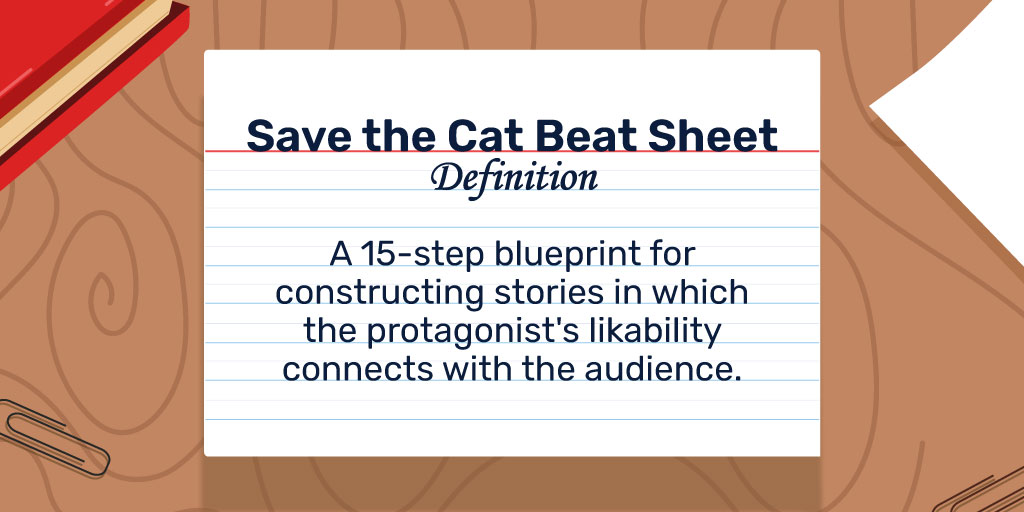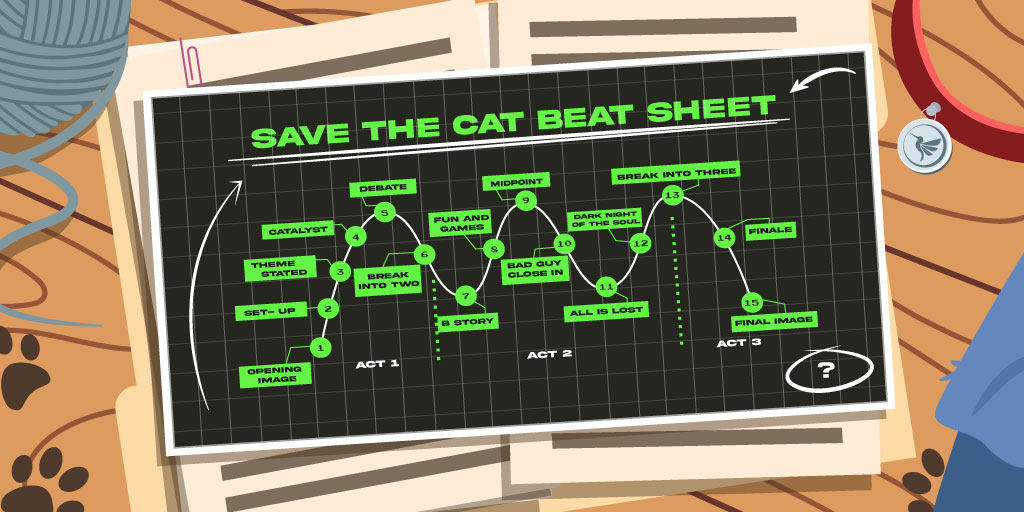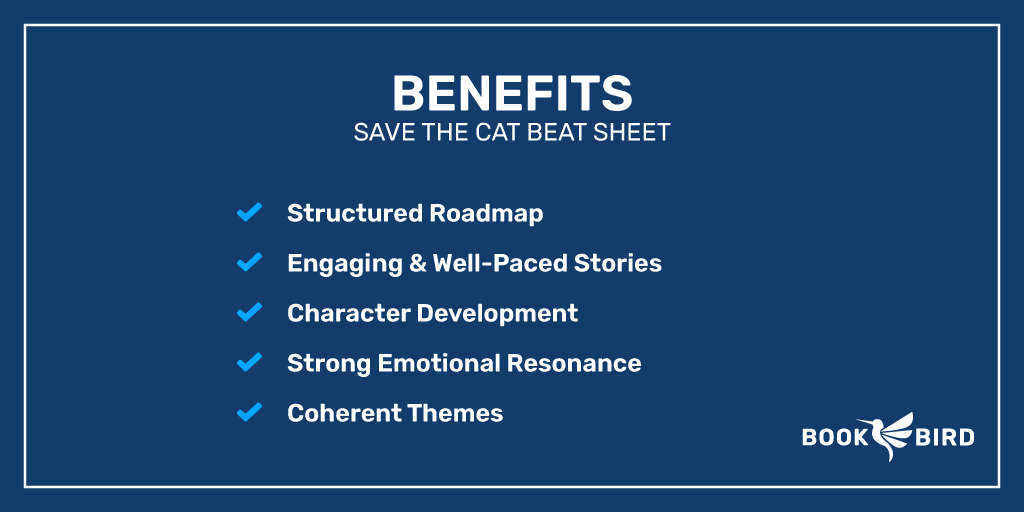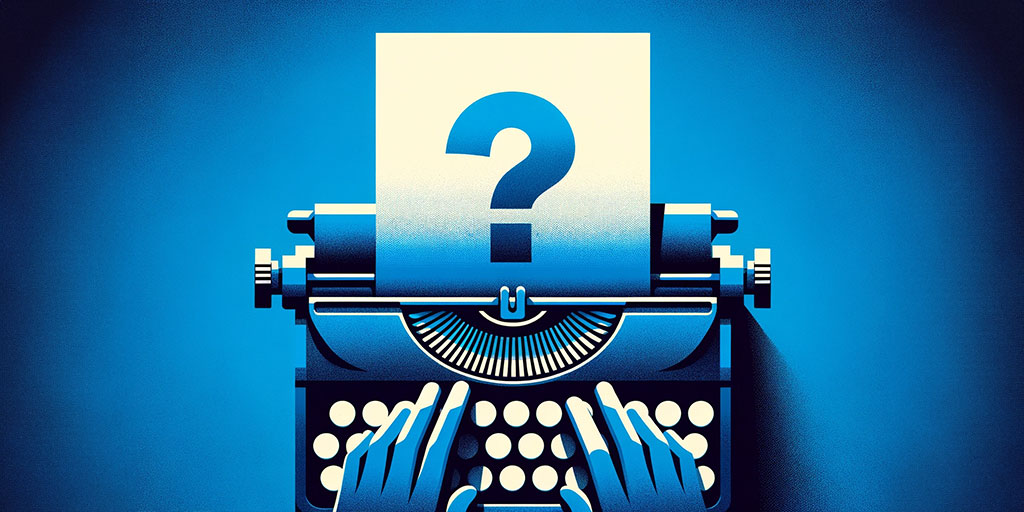The three-act story structure has long been the go-to framework for shaping narratives, encompassing exposition, confrontation, and resolution. Yet, even the most skilled authors often find themselves wrestling with the vastness of these sections, struggling to fill in the details.
By breaking down the three acts into clear, actionable steps, the Save the Cat Beat Sheet ensures that no piece of your story remains unexplored, no character is left undeveloped, and no reader is left unengaged.
In this guide, we venture into the world of this beat sheet, unraveling its powerful approach to storytelling. Discover how this technique empowers authors to infuse each beat with purpose, guiding them through crafting a captivating beginning, an enthralling middle, and a satisfying ending.
What is the Save the Cat Beat Sheet?

The Save the Cat Beat Sheet is a popular story structure and outlining method developed by screenwriter Blake Snyder.
The core idea behind the Blake Snyder Beat Sheet is to provide a framework that helps writers structure their stories effectively while ensuring they engage the audience emotionally. The method is applicable to screenplays, novels, and many other forms of storytelling.

The 15-beat sheet structure spells out the essential beats designed to create a compelling narrative arc, from the opening scene to the climax and resolution. It aims to guide writers in building a story that evokes emotional responses and satisfies the audience with a fulfilling conclusion.
The beats are strategically placed to maintain good pacing and to prevent the story from feeling slow or rushed.
This detailed step-by-step guide contrasts, for example, with the three-act structure that gives only the most basic guidance. It includes only exposition, confrontation, and resolution, which may leave writers with underdeveloped story settings, sagging middles, or plot holes.
Origins of the Save The Cat Beat Sheet
The Save the Cat Beat Sheet was developed by Blake Snyder, a Hollywood screenwriter and author, as a tool to help aspiring screenwriters create compelling and marketable screenplays. He noticed patterns and common elements that successful movies shared, and he distilled these insights into a story structure that he believed would resonate with audiences and industry professionals alike. His 2005 book “Save the Cat!” quickly became a best-seller and an essential resource for Hollywood screenwriters.
The term “Save the Cat” comes from his recognition that all successful stories include likable and relatable protagonists. He attributes the failure of the 2003 movie “Lara Croft: Tomb Raider – The Cradle of Life” to the fact that it tried to make Lara Croft cool and sexy instead of sympathetic and emotionally engaging.
The idea for the name goes back to the 1986 film “Aliens.” In the movie, an officer’s cat vanishes, with viewers fearing it would fall prey to a ferocious extraterrestrial lurking on her spaceship. Snyder realized that whichever character saved the cat would earn an instant positive emotional connection with the audience.
Craft of Writing Quiz (Easy)

15 Stages of the Save the Cat Story Structure

The Save the Cat Story Structure consists of 15 essential beats or plot points that help create a well-structured and emotionally engaging narrative. Below you will find a detailed explanation of each step and the percentage point through the story in which Snyder believed it should appear. We will use Ray Bradbury’s dystopian novel “Fahrenheit 451” to illustrate the steps.
This story is set in a future society where books are banned and firemen are tasked with burning any books and the houses in which they are found. We follow Guy Montag, a fireman who begins to question his role in destroying knowledge and promoting mindless conformity in the name of what the government calls happiness.
Beat #1: Opening Image (0-1%)
This is the very first shot or scene of the story, setting the atmosphere and providing a glimpse of the world or situation the protagonist is in at the beginning. It should have a hook that piques the audience’s curiosity and compels them to keep reading to find out what happens next.
It’s short and snappy at only one or two paragraphs and often contains powerful imagery, symbolism, or foreshadowing.
For instance, before the beginning of the first chapter, “Fahrenheit 451” begins with a statement that captures its tone and subject: “Fahrenheit 451: The temperature at which book-paper catches fire and burns.”
The first paragraph depicts the still unknown main protagonist burning down a house that has books in it.
Beat #2: Theme Stated (5%)
Here, readers encounter the central theme or message that the narrative will explore throughout. This is a fundamental and underlying concept that the story aims to convey, often carrying a broader message or moral lesson. It gives it depth and meaning beyond the surface plot.
The theme can be implicitly presented through subtle cues, dialogue, or symbolic elements or explicitly stated through direct conversations or narration. It might involve a character expressing their beliefs or values, either in a dialogue or as a reflection.
In “Fahrenheit 451,” this beat introduces the theme of censorship and the suppression of knowledge. It sets the stage for exploring the consequences of a society that bans books and controls information.
In his first conversation with his new neighbor Clarisse McClellan, whom he runs into while walking home, she asks him whether he ever reads the books he burns. He reminds her that it is illegal to read books and accuses her of overthinking.
Beat #3: Setup (1% – 10%)
In this beat, the writer introduces the audience to the protagonist’s ordinary world and provides essential information about their life, relationships, and the status quo.
It contains some of their background, personality, and goals. In addition, it introduces the setting, time period, significant supporting characters, and their normal routines before the inciting incident disrupts their existence.
For example, we learn the name of the main protagonist, Guy Montag. He is proud of being a fireman that burns books. He also defines the mindless conformity the regime’s inane entertainment programs instill in the people. He doesn’t think or know much about anything and feels very little, including for his wife Mildred, who is just as vacant as him. We learn that he lives in a society where it is illegal to read books.
Beat #4: Catalyst (10%)
This beat marks the inciting incident that sets the narrative in motion. It disrupts the protagonist’s ordinary world and introduces the central conflict they must face throughout the rest of the story.
The Catalyst presents them with a situation that demands a response, forcing them to make a choice that will lead them on their journey. It guides them toward the central conflict and provides a clear goal or objective for them to pursue.
Montag’s life is disrupted by conversations with Clarisse McClellan. She contrasts today’s world, where people are violent and nobody ever talks about deeper issues, with a past world in which people weren’t always fighting and did talk. He notices that, unlike everyone else, her family often talks instead of unthinkingly watching the parlor walls (television screens that broadcast nonstop entertainment, interactive dramas, or sport.)
Beat #5: Debate (10%-20%)
The protagonist faces internal conflict and uncertainty in response to the Catalyst. They’re torn between their desires for a comfortable, familiar life and the unknown risks and challenges the Catalyst presents. It’s common to resist the call out of fear of the unknown or the potential consequences.
Their past experiences or traumas usually drive their thinking, but supporting characters also play a role in the debate, providing advice or guidance that influences their decision-making.
Clarisse’s question about whether Montag is happy, plus Mildred’s attempted suicide, makes him contemplate whether he and anyone else is actually happy. He realizes that something is wrong with the status quo in which no one knows anything, and society cannot learn from history to avoid serious mistakes.
Mildred couldn’t even remember that she had just tried to kill herself, which made her believe that she, and Montag, too, were probably so vacant that they could just as well be permanently asleep. Neither of them could even remember where and how they had met ten years before.
Beat #6: Break into Two (20%)
At this point, the protagonist makes a definitive decision to embrace the main conflict and sets off on their journey, leaving behind their ordinary world. Their goal or mission becomes clear, and they have an obvious direction, setting the stage for the challenges and obstacles they will face in the upcoming adventures.
Montag starts to collect books and hides them in his house. When a woman sets herself and her house alight rather than watch them burn her books, he steals one from her house, believing that books must have value if people are willing to die if they cannot keep them.
Beat #7: B Story (22%)
A supporting character or subplot enters that provides emotional or thematic support to the main story. The B Story usually creates an emotional connection between the protagonist and supporting characters, but it doesn’t have to be romantic. It may reflect or contrast the central theme of the main plot, either reinforcing the story’s themes or offering a different perspective on them.
After stealing the book from the woman’s house, Montag senses a mechanical hound outside his house while he is trying to sleep and remembers that it growled at him at the fire station days before. This is a subplot, as it introduces the idea of controlling people with surveillance and violence carried out by technology.
Another thematic contrast to the main story emerges when his superior fireman officer, Captain Beatty, tells him that this dumbed-down world originally came from the people themselves, not from the government. Everyone wanted everything to be shorter, simpler, and easier, which they now have.
Beat #8: Fun and Games (20% -50%)
The protagonist experiences excitement, adventure, and initial success as they navigate the new world they’ve entered. It is a phase of discovery where they learn about the rules of the new environment.
They experience early successes or triumphs, which boost their confidence and motivation, and acquire new knowledge and skills, often with the help of supporting characters.
Now that Montag has collected some books and believes they are valuable to escape the unacceptable status quo, he starts reading them. Mildred doesn’t see their value, and she realizes that she needs help to understand them.
Beat #9: Midpoint (50%)
This beat marks the middle of the story and serves as a turning point that significantly shifts the narrative. It often introduces a major revelation, twist, or change in direction that raises the stakes and propels the story toward its climax.
The revelation or discovery usually alters the protagonist’s understanding of the central conflict or their goals. It can change the course of the story and create new challenges. It typically intensifies the tension and suspense in the story, keeping the readers eager to see how the protagonist will respond.
After initial reluctance, a retired English professor, Faber, finally agrees to take Montag as his student. To facilitate their communication, Faber provides Montag with an earpiece.
Upon arriving home, Montag feels defiant and starts reading a book to his wife and two of her friends. They leave the house in tears, and Mildred is angry with him.
Beat #10: Bad Guys Close In (50 to 75%)
Here, the protagonist faces increasing challenges, setbacks, and opposition from the antagonistic forces, demonstrating their strength and cunning. The protagonist cannot gain an advantage.
This often involves significant losses or sacrifices for them and their allies. This heightens the emotional stakes for the readers.
Upon Captain Beatty’s command, Montag is forced to incinerate his own house, learning that his wife and her friends had reported him for his book reading the previous night. But during this process, Beatty discovers Montag’s hidden earpiece and becomes determined to track down his mentor Faber.
To prevent this, Montag sets Beatty ablaze and strikes his other co-workers unconscious. After the mechanical hound attacks him, he burns that, too, and limps off.
Beat #11: All Is Lost (75%)
The antagonistic forces have the upper hand, and all hope seems lost. The central conflict appears insurmountable, and the protagonist is defeated. They experience a moment of extreme despair and defeat. It is a low point in the story where readers fear for their hero.
Montag discovers that there is a big manhunt for him. A vehicle almost runs him over, and he sees on television that more mechanical hounds have been dispatched to hunt him down.
Beat #12: Dark Night of the Soul (75% – 80%)
This stage represents a moment of profound inner turmoil and self-doubt for the protagonist. It is often a moment of soul-searching and reflection where they confront their deepest fears and weaknesses.
They may feel defeated, disillusioned, broken, or alone. Sometimes they question their abilities, their commitment to the journey, or the value of their goals, and sometimes they feel alone and like they’re burdening others with their troubles. Past wounds or traumas may resurface during this beat, compounding their emotional turmoil.
Montag runs to Faber’s home for protection but quickly realizes he is endangering him. He doesn’t know where to go or what to do next.
Beat #13: The Break into Three (80%)
In this beat, the protagonist experiences a moment of revelation or a new understanding that leads to a change in their approach or strategy. It marks a turning point where they regain their determination and find a new plan or solution to overcome the final challenge. This stage creates a sense of hope and anticipation as the audience sees them finding a way to overcome the obstacles in their path.
Professor Faber urges Montag to leave the city and contact the exiled book lovers who live there. He escapes the manhunt by floating down a river into the countryside. He meets the exiled drifters and their leader Granger.
Because of Granger’s accurate prediction about how an innocent person will be set up as him and killed to satisfy society, Montag realizes how intelligent they are because of their books. This recommits him to his goal and supplies him with allies.
Beat #14: The Finale (80%-99%)
The protagonist faces the final and most significant challenge of the story, leading to the ultimate confrontation with the antagonistic forces. It is the climax of the narrative, where the stakes are at their highest and the resolution of the central conflict hangs in the balance.
These obstacles are often more intense and difficult than any they have faced before. It demonstrates how they have grown through the story to face the challenges head-on.
Military planes appear in the sky above the city and pulverize it with nuclear weapons. Because they live as rebellious exiles in the countryside, Montag and his book-loving friends are only injured and not killed. The destruction of the mindless society ultimately confirms their belief that a lack of knowledge and understanding of why things happen is a dangerous way to live.
Beat #15: Final Image (99%-100%)
The story concludes with a visual representation or reflection of the protagonist’s transformation throughout their journey. The Final Image provides a sense of closure.
It may reinforce the central theme of the story and the lesson the narrative conveys. This end should emotionally impact the audience, evoking feelings based on the protagonist’s triumph, sacrifice, or personal growth.
The exiles return to the city to rebuild a society based on knowledge to avoid the mistakes that led to the previous one being wiped out.
How to Use the Save the Cat Story Structure

Because of its very detailed guidance from beginning to end, this beat sheet template provides most of the help that authors need. But there are some further strategies to keep in mind if you want it to be especially effective. Pay special attention to the tips below.
Understand the 15 Beats
Familiarize yourself with the 15 beats of the Save the Cat Story Structure. Each beat serves a specific purpose in the storytelling process. For example, beat #1 is an attention grabber, while beats #9 to #14 drive up the stakes and the intensity of the action.
Since the beat sheet is based on years of research on successful stories, it is best to let each beat in your story fulfill its specific role.
Start with a Strong Logline
Before you begin writing, craft a clear and compelling logline that encapsulates your story’s protagonist, the inciting incident, their goal, and the stakes, all in one sentence. This will be a guiding beacon to prevent you from going off track throughout your writing process.
Consider the following examples:
- When a curious young archaeologist (protagonist) stumbles upon a mysterious portal hidden deep within an ancient ruin (inciting incident), she must embark on a perilous journey through fantastical realms to rescue her kidnapped mentor (goal) and prevent a malevolent sorcerer from unleashing chaos upon the world (stakes).
- When a curious teenager (protagonist) learns about a mysterious circus that only appears at midnight (inciting incident), she must unravel its evil plans to destroy the town (stakes), all while discovering her unique talents that may hold the key to escaping its grasp (goal).
For every step of the beat sheet that you complete, check back to see whether it is still consistent with your logline and whether it is still taking your story where you want it to go.
Establish Engaging Characters
Develop relatable and well-rounded characters that resonate with your readers. Ensure each character has clear goals, motivations, and conflicts that align with the overall story arc.
To remain consistent with the concept of Save the Cat, make your main protagonist do something close to the beginning of the story that endears them to your audience. It’s fine if this protagonist is flawed, but make them appealing enough so your readers care about what happens to them. Let them do something that indicates loyalty, humility, bravery, protectiveness, generosity, empathy, or kindness.
Introduce the Catalyst Early
The Catalyst, or inciting incident, should be introduced early in your story to grab your readers’ attention and set the narrative in motion. The setup or exposition should not take over 10% of the story; otherwise, your audience will become impatient or bored.
Raise the Stakes
Continuously raise the stakes to keep your readers invested and emotionally engaged. This is especially important between beats #9 and #14, which represent the second half of your story. Your readers are rooting for the characters. Make them feel their fear of failure, physical danger, and even death as they struggle to meet their goals and defeat their enemies.
Spell out what will happen to them if they fail. Will a loved one dump them? Will they lose their home? Will they be hurt or tortured? Will they die? Will something terrible happen to innocent bystanders? Will they lose their reputation?
Maintain Consistent Themes
Ensure your story’s themes are evident throughout the narrative and tie into the protagonist’s journey and growth. If you don’t know exactly what the deeper theme will be when you start writing, build it into the story once you’re done. A theme should not be stated only at the end of a story. It is the backbone of the story and should appear throughout, even if the fully developed one only becomes apparent at the end.
The theme communicates a central idea that the readers can keep in mind throughout the reading experience. It can capture their attention and pique their curiosity. And it can help them to understand the deeper elements of the character’s actions and choices.
Be Flexible and Adapt
While using the Save the Cat beats can be helpful, remember that storytelling is an art form, and it’s fine to adapt and modify the structure as needed to suit your narrative’s unique requirements.
If you don’t have a subplot, drop beat #7. If your protagonist never succeeds at navigating their challenges, drop beat #8. If they don’t have a choice whether to respond to the Catalyst or not, drop beat #5.
While the other beats are probably necessary for a good story, you can change when they happen. For example, if you write an action-packed thriller, ramping up the intensity before you get to 50% is perfectly fine.
Pros and Cons of the Save the Cat Beat Sheet
Let’s explore the advantages and limitations of the Save the Cat Beat Sheet, shedding light on how it can elevate storytelling while acknowledging its potential constraints. Understanding these aspects will help you to make informed decisions when incorporating it into your writing.
Benefits of the Save the Cat Story Structure

From enhancing pacing and character development to creating a sense of purpose and resonance, the benefits of this storytelling tool are bound to elevate the craft of any author seeking to captivate their audience. Here are its strengths:
- Structured Roadmap: The 15 beats provide a clear and structured blueprint for you to follow while crafting your stories. It helps you stay organized and focused on essential plot points, preventing the story from becoming aimless or meandering.
- Engaging and Well-Paced Stories: You can create a well-paced narrative with well-timed twists, turns, and climaxes.
- Character Development: The framework ensures that characters undergo meaningful growth and development throughout the story, which makes them more relatable to readers.
- Strong Emotional Resonance: By emphasizing the importance of emotional moments in a story, this approach enables you to evoke strong emotional responses from readers.
- Efficient Revision: You can focus on refining specific beats and ensuring that each plot point serves its purpose, leading to a more cohesive and polished final manuscript.
- Coherent Themes: By encouraging you to incorporate a clear theme into your stories, it helps tie the narrative together, providing a deeper meaning and purpose to the events in the plot.
Drawbacks of the Save the Cat Story Structure

The Save the Cat Structure may not suit every author’s creative style or the unique requirements of their story. Be mindful of the following potential risks of its use:
- Restrictions on Creativity: For some authors, the rigid adherence to specific beats may stifle creativity and limit their ability to follow their creative instincts.
- Challenge for Complex Plots: This structure best suits straightforward and linear plots. If you work with complex or nonlinear storylines, you may find it challenging to fit your narrative into the prescribed beats.
- Formulaic Feel: Following the beats too rigidly can lead to a formulaic or predictable storyline that some readers may find predictable.
- Artificial Scene Placement: Forcing your story into specific beats might lead to non-natural scene placement, negatively impacting the story’s coherence and authenticity.
Frequently Asked Questions
If you still have questions about whether and how to use the Save the Cat Beat Sheet, this section answers the most common ones.
Why is It Called Save the Cat?
The Save the Cat Story Structure gets its name from a specific moment in the movie “Aliens” (1986), in which a character saves a cat from danger. The term was then popularized by screenwriter Blake Snyder, who used it to refer to the need for main characters to perform acts of kindness to make them sympathetic and likable to the audience.
Why Do Writers Use the Save the Cat Beat Sheet?
Writers use the Save the Cat Beat Sheet because it provides a structured framework with 15 essential beats that help craft engaging and well-paced narratives, create relatable characters, include themes, and evoke emotional resonance in their stories.
Can the Save the Cat Beat Sheet Be Used for Any Genre?
The Save the Cat Beat Sheet can be used for any genre. While initially developed for screenwriting, its flexibility and broad applicability make it suitable for other storytelling formats like novels. And it works for any story genre, from romance, thriller, fantasy, science fiction, drama, and any other.
What if My Story Doesn’t Fit into All the 15 Beats?
If your story doesn’t fit perfectly into all the 15 beats of the Save the Cat Beat Sheet, omit those that don’t fit. So long as it adheres to most of the structure, with the same emphasis on theme, conflict, and character growth. Trust your instincts as a writer and stay true to your vision for your story.
Can the Save the Cat Story Structure Be Used for Series?
Yes. The Save the Cat Story Structure can be used for series. In such a case, the entire story is structured according to the 15 beats. However, the risk of this approach is that the individual episodes early in the series might be quite boring because of being starved of conflict. A better approach is to build some of the conflict beats into each episode within the series to ensure they’re all engaging.
Final Thoughts
By providing a clear roadmap with 15 essential plot points, the Save the Cat Beat Sheet can help you to write well-paced plots, develop relatable characters, create deep themes, and evoke a powerful emotional connection with your readers.
And, if it doesn’t fit your story perfectly, you can still adapt it for your purposes and allow your unique voice and creativity to shine through.
Craft of Writing Quiz (Hard)








